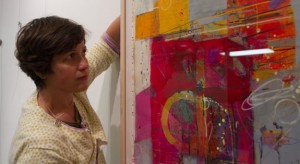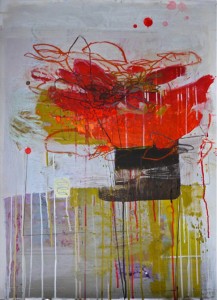When local artist Melissa Zarem began many of the pieces in her latest collection, she started on the hardwood floor of her studio.

“I’ll put my sheet of paper on the floor, and it’s sometimes a color that’s left on my palette from whatever I was working on, and I’ll just start,” she said.
She usually begins with her broadest brush, the cheap kind from Agway, because “the best artists use the cheapest tools” — a joke with a hint of truth for Zarem. The less expensive brushes produce that hairy, straggling-line look she aims for.
Then, with her entire petite body bent in half over the canvas, her gestures add color to the page. She makes these first strokes without much concern or planning.
“For me, it’s a lot about just starting something without worrying what it’s going to look like, and then giving it some time so I can respond to it,” she said.
Zarem’s current collection of abstract pieces, titled “Closer to the Skin,” was put on display Tuesday at the Community Arts Partnership Artspace on the Commons and will continue to show for the rest of October.
The pervading concept through the exhibition is the meeting and interaction of objects and ideas, and the border of those meetings is where the conflict is the strongest, Zarem said.
“Boundaries are sort of an opportunity for things to either complement or contrast, and so it could be the boundary or an edge between colors or shapes or textures or whatever,” she said. “That is one of the things that I am always working on. I am interested in how things meet up against each other and how they interact.”
To explore this idea, Zarem uses crayon and graphite to cut into the gouache acrylic paint, which highlights the line where the two materials touch.
She began the pieces this spring in her small studio tucked away in her basement.
The little room is meticulously organized with her paints, worn-down brushes and Plexiglas palette sitting on top of a metal shelving unit in one corner and all of her printing materials — old plastic toys, lids, stamps, a cut-up loofah — on a table in another corner.
Next to her printing materials is a large metal case with drawers full of finished pieces, discarded works and old materials from when Zarem worked with collages. A drum set sits in the corner of the room, a subtle reminder that as a full-time mom as well as an artist, she shares the room with her two daughters.
Though she graduated from the College of Architecture, Art and Planning at Cornell University in 1988, Zarem has only returned to producing art on a larger scale in the past five years, after returning to Ithaca from Brooklyn, N.Y. After college, she worked as an artist-in-residence at the Henry Street Settlement House’s Abrons Arts Center in New York City, but took a hiatus from art to raise her children. In the past four years, she has been featured in five shows at the State of the Art Gallery and had her first solo show at the Corners Gallery in June.

Zarem’s work was chosen for the CAP show by an anonymous group organized by CAP of Tompkins County.
Robin Schwartz, program director for CAP, said she was excited to show Zarem’s work because of the vibrant look of the show.
“Melissa’s work is going to look fantastic in our galley,” she said. “Her work is so beautiful, colorful. Her abstracts are some of the best that I’ve seen.”
The title of her current exhibition comes from a piece of advice a friend from Trinidad offered to her about taking care while pealing a mango because the sweetest part of the fruit is always “closest to the skin”. Not only good advice, Zarem said, these words struck her as a good metaphor for her work.
“It refers to an unconscious piece of tactile information, and a lot of my work resembles that,” she said. “It’s done with a blend of spontaneity and unplanned gestures, combined with more control and thinking ahead.”
As with most of her pieces in her current abstract style, after the initial strokes of impulsive creation are placed on the page, Zarem starts to make a plan for the piece.
“For me, all art is about making choices,” she said.
So when the first layer of paint has dried, it’s time for the work to move onto the next stage in the process — the wall. The largest surface in Zarem’s studio, the front wall, is her easel. It is covered in dripping lines of paint — bright pinks and yellows, vibrant red, black, shades of green, blue and grey.
There’s no room for perspective as the work lies on the floor, Zarem said, so its corners are tacked up and put on unfinished display. Initial impulses and instincts are added to the page first. Then it’s time to take a step back, sit in the brown leather chair strategically placed across from the display wall and look at what has been done.
“And then the whole process feels like that’s when it really begins,” Zarem said. “It’s a conversation back and forth between what I’m seeing, what it means, what else I’m working on at the same time, and it just keeps going like that for a little while.”
She may add a mark here, throw in a color there, all based on her observations.
Leslie Daniels, a local writer and friend of Zarem’s, sometimes comes to the studio to do her own work alongside Zarem. Daniels said she is intrigued by the work because Zarem maintains such a clear awareness through her process.
“She has tremendous integrity of vision,” she said. “Her palette will change a lot. The texture and the shapes and so on will change a lot. There’s a spirit of playfulness and authority that comes through in all her pieces.”
From the wall to the floor, Zarem goes back and forth working with the piece, turning and viewing until it is finished. She said her organic process allows her to explore the spontaneity of abstract art.
“I just go,” she said. “Because working on something over time in layers gives you the confidence that you’ll figure it out as you go. It doesn’t have to be right that first time. I know that I’m going to build up to something I feel good about.”
There will be a reception for “Closer to the Skin” at 5 p.m. Friday at the Community Arts Partnership Artspace on the Commons. Zarem will also give a free artist talk at
6:30 p.m. Oct. 17.





